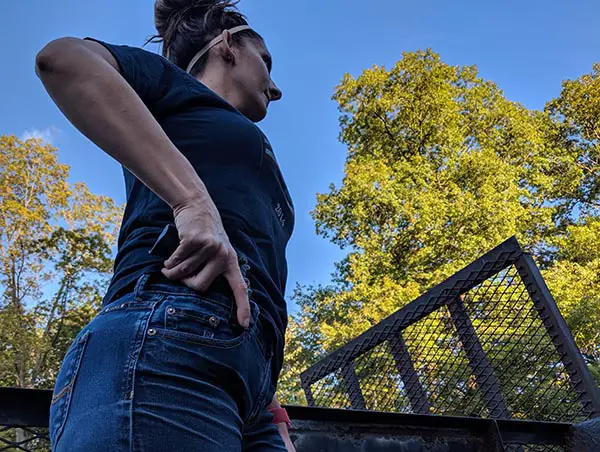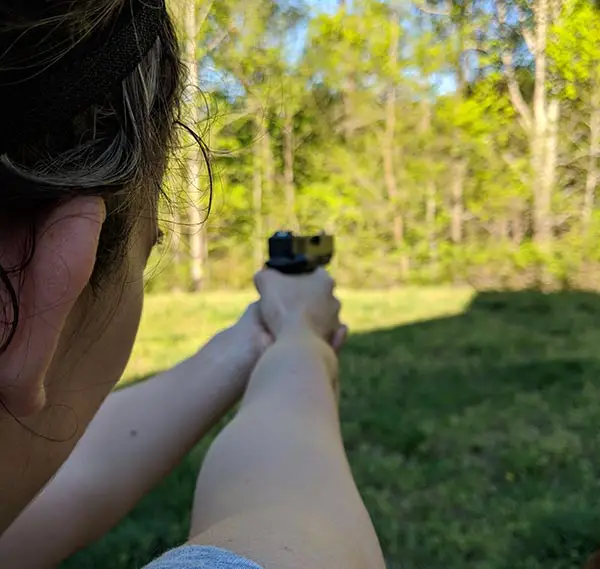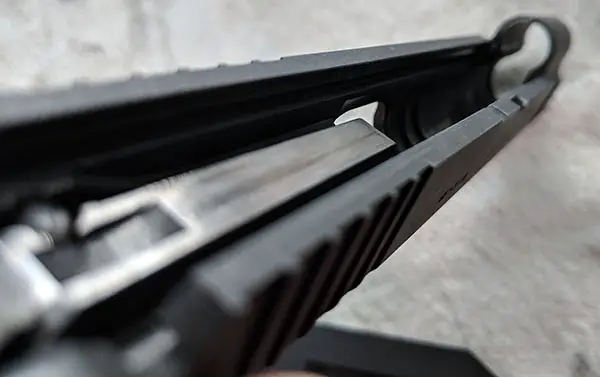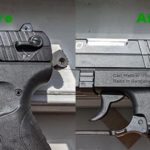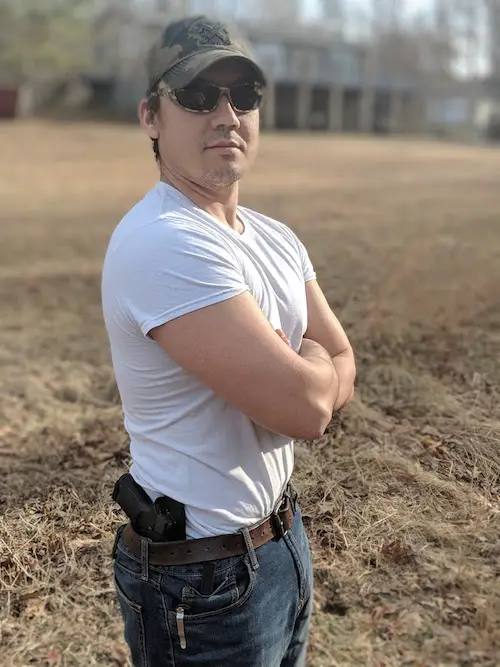In a world where striker fired pistols are becoming evermore popular, the double-action/single action pistol (DA/SA or SA/DA for short) can be a mystery. Pistols come in a variety of configurations, and you may be wondering how to carry your DA/SA pistol. You can carry a DA/SA pistol in up to 5 different configurations.
- Empty chamber
- Single Action: Loaded chamber, hammer cocked, & safety off
- Single Action: Loaded chamber, hammer cocked, & safety on
- Double Action: Loaded chamber, hammer decocked, & safety off
- Double Action: Loaded chamber, hammer decocked, & safety on
Table of Contents
What Is A DA/SA Pistol?
The terms “SA/DA” and “DA/SA” can be used interchangeably. However, it’s important to note that, the terms “double action” and “single action” refer to the purpose of the trigger on your pistol. A double action (DA) trigger both cocks the hammer and releases it to strike the firing pin. However, a single action trigger, only releases the hammer from the cocked position. Therefore, a hammer must be able to maintain the “cocked” position to have a DA/SA trigger.
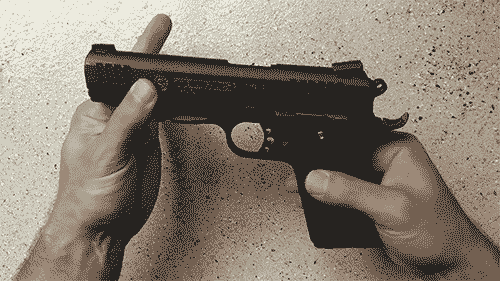
Pistols can also be single-action only (SAO) or double-action only (DAO). For instance, my Taurus 1911 has a single action only trigger with a skeleton hammer. Squeezing the trigger while the gun is in the de-coked/half-cock position will not result in the hammer setting to the full cock position.
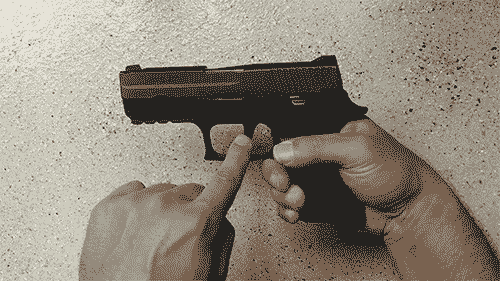
Alternatively, my Sig Sauer is a double action only pistol with a recessed hammer. Therefore, you cannot physically cock the hammer (and have it set). Squeezing the trigger is the only way to get the hammer to fully cock.
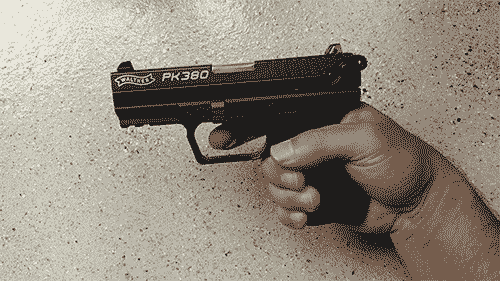
However, pistols with DA/SA triggers have the option to be carried in either configuration. Above is an animation of my Walther using both a double action trigger, and a single action trigger. Notice the staging of the trigger when the hammer is cocked. Striker fired pistols are another beast, and I won’t get into that today.
Automatic vs. Revolver Trigger Actions
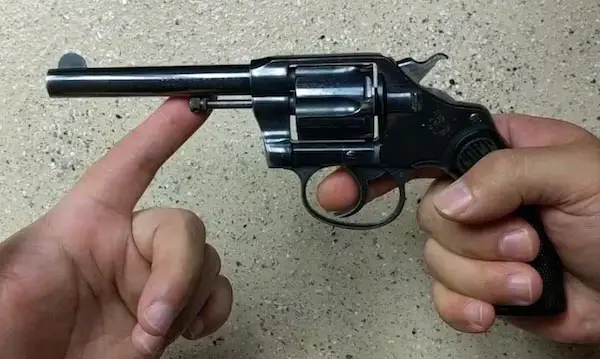
DA/SA pistols come in both automatic and revolver varieties. However, there is a fundamental difference between the two. Revolvers require an exposed hammer to be DA/SA. However, automatics do not require an exposed hammer. The hammer on an automatic will be cocked by the action of the slide.
To place a revolver trigger into single action, the hammer must be cocked manually. Therefore, a revolver with a recessed hammer is not a DA/SA revolver. Cocking the hammer on a revolver also rotates the chambers of the wheel as the trigger is staged.
Another difference between automatics and revolvers is the mechanism to de-cock the pistol. Automatics can be de-cocked via a lever, or by manually lowering the hammer (thumb should maintain control of the hammer) while squeezing the trigger. However, revolvers can only be lowered manually.
Finally, the biggest difference between an automatic and revolver is the trigger action following the first discharge or a round. Most revolvers will revert to a double action trigger after the first round is fired (regardless of whether the trigger was set to DA or SA). However, automatics are the opposite. Generally, an automatic will transition to single action after a round is fired. This is because the movement of the slide automatically cocks the gun, thereby staging the trigger.
Different Ways To Carry A DA/SA Pistol
Handgun features vary greatly and to cover every model pistol individually wouldn’t be helpful (not to mention difficult). Therefore, I’ll be addressing common features found on many DA/SA pistols.
Oftentimes, DA/SA pistols will have an external safety. However, this is not always the case. But, I’ll be including this feature for thoroughness sake. For the purposes of this section, I may also use the terms “half-cock” and “de-cocked” interchangeably. This is simply to illustrate that the hammer is not in the full cock position.
Carrying With An Empty Chamber
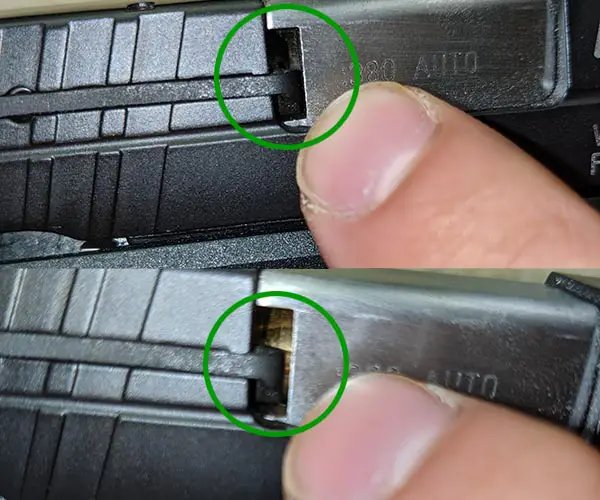
One way you can carry your DA/SA pistol is with an empty chamber. This means no round has been loaded and this is will not fire. I cover my philosophy on carrying a loaded gun in another article. Above is an image of my Walther PK380, with the loaded chamber indicator showing no round has been loaded.
Carrying your DA/SA with an empty chamber is easily the safest method (short of not having a magazine loaded). However, it is also the least practical for self defense. Once you draw the handgun from your holster, you’ll need to chamber a round before firing. Therefore, carrying an DA/SA handgun in this method uses up valuable time. Additionally, you may experience a malfunction (e.g. failure to feed) when attempting to load your pistol.
If the chamber of your pistol is empty, squeezing the trigger will not result in the discharge of a round. Therefore, when the chamber is empty, there is really no need to engage an external safety. Finally, unless you manually rack the slide or cock the hammer, your trigger will default to double action.
Single Action: Loaded, Cocked, and Safety Off
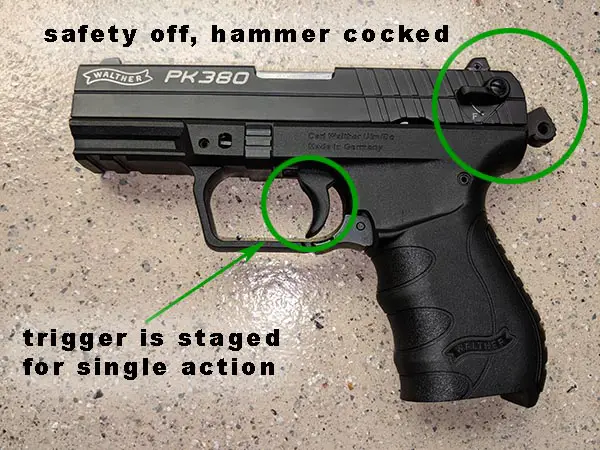
Next, we’ll move to the complete opposite end of the spectrum. Another way you can carry your DA/SA handgun is with a loaded chamber. With a loaded chamber, the hammer cocked, and the safety disengaged the weapon is ready to fire. Carrying your DA/SA pistol this way is the most dangerous of all your options. Carrying your pistol in condition 0, is more dangerous than any other condition. However, I feel that trigger being in single action makes this method the least safe.
Single Action = Staged Trigger
When you cock the hammer on your DA/SA handgun, you may notice the trigger becomes staged. When the trigger is staged, it sets just prior to the point when the trigger “breaks.” When the trigger breaks, the hammer falls, and a round is fired. Therefore, a staged trigger requires a minimal amount of pressure for the trigger to break and the gun to discharge. Because the trigger pull is less on a staged trigger, it makes a negligent discharge more likely.
Single Action: Loaded, Cocked, and Safety On
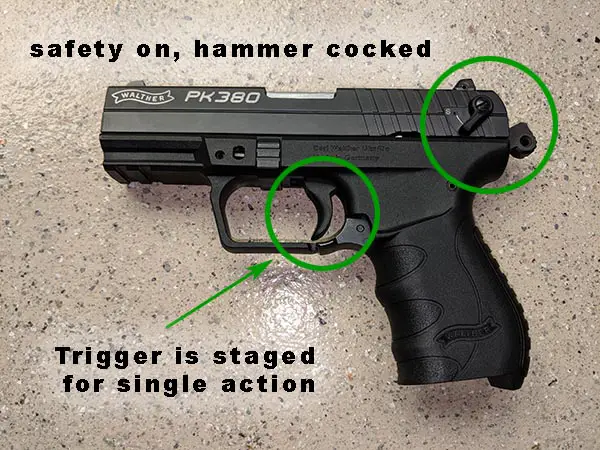
Next, we’ll be talking about carrying your DA/SA pistol with a loaded chamber, the hammer cocked, and the safety on. Condition 1 is safer than the Condition 0 for carrying your concealed DA/SA pistol. However, it relies exclusively upon the external safety (not counting user error) to prevent an accidental discharge.
Because the hammer is cocked and the trigger is staged, your pistol is in single action. However, the external safety helps to prevent accidental discharges described in the previous section.
My qualm with concealed carrying a DA/SA pistol this way is disengaging the safety. You will need to be able to un-holster your weapon and disengage the safety before firing. Target acquisition and sight alignment may suffer if you aren’t accustomed to simultaneously disengaging the safety during your draw.
Double Action: Loaded, Decocked, and Safety Off
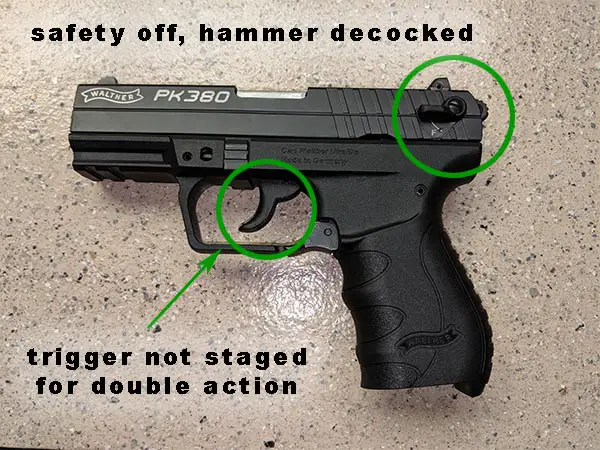
Alright, now we get to my preferred method of carrying my DA/SA pistol. If you concealed carry a DA/SA pistol with one in the chamber, the hammer de-cocked, and the safety off you’ll technically be in condition 0. Although, I personally consider it condition 1.5 since the hammer is de-cocked similar to condition 2. For a DA/SA pistol, the trigger is in double action mode.
I prefer this method, because it was how I always used to carry my Sig. However, my Sig Sauer pistol has a double action only (DAO) trigger. Carrying a concealed pistol in this method allows you to un-holster the weapon and fire unimpeded by a safety. However, because the trigger is not staged, it makes it less likely that a finger slip will cause the weapon to discharge.
This method of concealed carry for a DA/SA pistol is not without risk. You can still snag the hammer on clothing when un-holstering your weapon. If the hammer is not cocked fully (i.e. remains in the cocked position) then drops it may still discharge because the safety is not engaged to prevent this.
Double Action: Loaded, Decocked, and Safety On
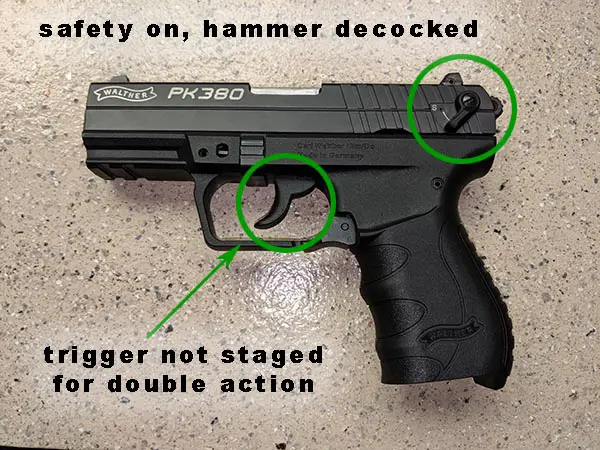
For those who are super wary and want safety redundancies, you can carry your handgun loaded, de-cocked, with the safety on — also known as condition 2. Because the hammer is de-cocked, the trigger will be double action, which provides some level of security from a negligent discharge. Additionally, the safety is engaged which is an added layer of protection.
Advantages Of DA/SA Pistols
The biggest advantage of a DA/SA pistol over other trigger platforms is it facilitates a smoother transition between trigger types. For example, moving from double action only to a single action striker fired pistol can be done in stages. By keeping the trigger in DA while holstered, your draw and first round will be more of what you are accustomed to. Eventually, you may decide to holster the weapon in single action instead. DA/SA pistols allow you to find your preference (or even change it) without having to purchase different weapons.
Another advantage of a DA/SA pistol is that it allows you to concealed carry with the weapon in a condition you feel is safest. Many individuals will not carry with a round in the chamber (especially with single action only pistols) because of the reliance upon an external safety. A staged trigger is more likely to result in a negligent discharge, and to avoid this people will keep the chamber clear. However, using a DA/SA pistol avoids the staged trigger by remaining in DA with the hammer de-cocked within the holster.
Disadvantages of A DA/SA Pistol
Although these pistols can make transitions between trigger types easier, training for both types can prove troublesome. Therefore, one disadvantage of DA/SA pistols is that you must train for both types of triggers.
For instance, I keep my Walther PK380 holstered in condition 2. Thus, my first round must be fired using a double action trigger. But subsequent rounds use a single action trigger because the weapon is an automatic. Therefore, I must train for this. I know that my first trigger pull is vastly different from the second, because of the change in trigger reset.
This leads to another disadvantage of these types of pistols. Because of the various pistol configurations, particularly with regard to external safeties, the learning curve for DA/SA pistols can be a bit high. You’ll need to spend plenty of time at the shooting range getting accustomed to your preferred setup.
Parting Shots
Although striker fired single action only triggers are all the rage, I prefer a bit more control over my firearm. With a DA/SA pistol I can augment how my weapon is carried. I am more comfortable concealed carrying my weapon in double action. Yet, I still get the benefits of a short trigger reset after my initial shot.
However, learning on this type of weapon does take diligence and practice. While this platform isn’t for everyone, for those willing to take a chance it can be irreplaceable. Do you carry a DA/SA pistol? How do you carry your pistol? Leave a comment below for myself and others to ponder!
